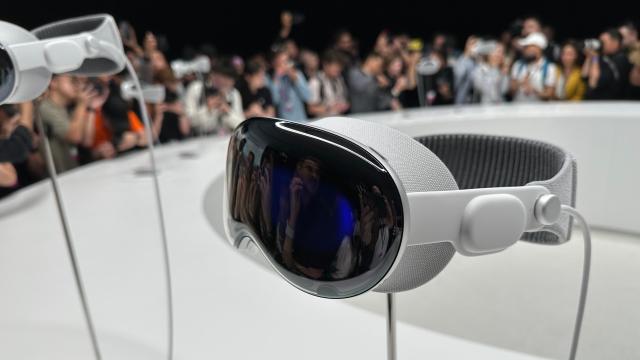Apple’s Vision Pro is set to make landfall from the company’s Cupertino spaceship headquarters Friday. Still, those who got to spend time with it early could finally break their silence Tuesday morning. From the fore, reviewers have walked away impressed with the VR headset’s strong displays, best-in-class passthrough, and hand tracking, but many also wonder just how much use they can get out of a $US3,500 headset sporting a connected two-hour battery pack.
Among reviewers, the most consistent praise was directed to the hardware, at least in terms of how much power it packs and how capable its eye- and hand-tracking sensors are. So far, most of the people who have tested the Vision Pro have called it one of the most advanced and consumer-ready all-in-one AR headsets released so far, though it’s brought down by a fair lack of apps or practical use cases.
There’s a lot to talk about, considering it’s such an expensive device promising to replace or compliment your other Apple desktop devices. Still, reviewers seem to agree the headset can handle all that you can throw at it. It’s running on the M2 chip, and Tom’s Guide noted that there was minimal lag running multiple apps like Slack Apple Music and streaming the screen from their MacBook with a simple glance, and all at the same time. You can access these apps from a digital crown akin to the Apple Watch, and these windows can be resized and placed around the room with relative ease.
Most reviewers praised the system’s 4K mini-OLED displays and low-latency passthrough capability. CNET’s Scott Stein called it “the best wearable display” he’s used so far, even above those that use base stations or those that require additional devices in the room. The passthrough will warn users if they walk too close to an object and also “ghost” other people who walk into the user’s field of view. Reviewers noted the Vision Pro has a solid pair of screens for working in the (currently rather limited) selection of virtual environments or for watching 3D movies.
Apple’s often given credit for the click wheel interface on its old iPod models, despite similar, earlier designs that used a wheel interface. In a similar way, while many other devices have stressed eye and hand-tracking, Apple seems to have come away with something impressive, if perhaps still needing a few software updates. Stein wrote that hand and eye tracking even works in low-light conditions. While most sites lauded the pinch method for controls, The Washington Post noted that the virtual keyboard isn’t as good as it could be, either by typing with your eyes or pinching keys.
One area of concern that’s cropped up constantly since a select few had a chance to try on the Vision Pro is the headset’s weight and comfort. It’s 1.4 pounds (excluding the external battery pack), but there have been a few lingering complaints that it caused headaches or neck strain. The Wall Street Journal’s Joanna Stern said she wore it for a full 24 hours (taking it off to sleep, of course). She described it as “big and heavy,” even with the band that included a top strap. The Vision Pro’s eye tracking would sometimes start to fail, forcing her to tighten and readjust the headset on her face. Still, she didn’t describe any pain from using it over that length of time.
Others did have some complaints about comfort. The Verge noted that compared to other headsets like the $US500 Meta Quest 3, Apple has put most of the weight on the front part of the headset, adding “you’re just going to feel it after a while.” The external battery is also a sore point. It weighs a little less than a pound (though more than your average iPhone) and is supposed to sit in your pocket. You can’t remove the cable attached to the battery to hot-swap them after the 2 to 2.5-hour battery life is all used up. The cable isn’t much of a hindrance, as “nothing about the Vision Pro feels like you’re supposed to move around that much in it.”
The Vision Pro comes with a headset, two straps (one with a top headpiece and one without), a battery pack, a charging cable, and a 30 W power brick with USB-C ports. YouTuber Marques Brownlee showed how the light shield and cushion attach magnetically. The Vision Pro sits mainly on the cheeks and forehead with the regular band, though Brownlee said the band with the top piece is much more “well distributed,” even if it messes up your hair.
The other consistent complaint was the “beta” 3D Personas used during FaceTime chats or in other video calls or conferencing apps. The various tech reviewers all joined on a call together and found themselves in the real pit of the uncanny valley. Stern wrote that her family members and coworkers told her she looked “frightening” and that the persona was “like Botox from hell.”
While reviewers heaped praise on the device, the main consistent question became just how useful this device was for the greater public, especially with its $US3,500 asking price. The Verge wrote that cameras and screens will necessarily show motion blur or flickers on other LCD screens. Most considered it as a test case for Apple’s eventual plans for augmented reality rather than a premiere consumer-fronted product. It’s a taste of CEO Tim Cook’s great AR dream, though a very expensive taste at that.
